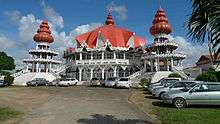Arya Dewaker
Coordinates: 5°49′11″N 55°10′30″W / 5.819631°N 55.17489°W


Arya Dewaker (Hindi वही आर्य देवकर) is a Hindu association that built probably one of the biggest Hindu temples of Suriname. The temple attracts many visitors, both Hindus and non-Hindus, coming from Suriname and from all over the world. It is located in the city centre fields in Paramaribo.
History
The temple was officially opened on 11 February 2001.[1] Since Arya Dewaker is the most important section of the Arya Samaj in Suriname today, it is reasonable to regard this house of worship as the main temple of the 29,300 Hindus who are said to belong this Hindu reform movement inspired by Swami Dayananda Sarasvati (1823-1883).[2]
Arya Dewaker was founded on 29 September 1929 on the initiative of Mehtā Jaimīnī, an Ārya Samājī who was exiled from India at the time. Arya Dewaker means 'Aryan Sun'. On 5 February 1930 the association received formal recognition from the Dutch colonial government.[3]
In 1936 the association constructed its first mandir, a temple, in which the members could convene and hold the ceremonies around a Vedic fire, which are characteristic for the Arya Samaj. However, it lasted until 1947 before the temple was officially inaugurated.[4] An Aryan temple, moreover, has no images.[5] Earlier they came together in classrooms which provisorily were arranged as temple halls. The house of worship constructed in 1936 was built according to the usual pattern of an Aryan temple.[6] It was demolished in 1975 to make place for a new temple, but because of a radical change in the construction plans and financial problems due to the bad economic situation of Suriname in the 1980s and 1990s the erection of this building took around twenty years.[7]
Symbolism of the temple
The new house of worship completed in 2001 differs entirely from previous Aryan temples, as the Dutch architect Arthur E. de Groot devised in good coöperation with the members of the board and the building committee of Arya Dewaker an octagonal building of two floors. The ground flour includes various meeting rooms and a library and the upper floor is the space where the ceremonies are performed. The place for burning the fire is in the centre of the hall, whereas the benches are placed in circles surrounding the fireplace, which emphasizes that all people attending the fire ceremony are in principle equal.[8] The building is octagonal, so it gives the impression that it is round, which reflects the circular form of the sun, the moon and the earth. The three towers refer to the three eternal units in our universal existence: the absolute God, human being and nature. The roofs of the two smaller towers and the tower on the big dome of the temple all have four floors, a number referring to the four Vedas, the oldest scriptures of Hinduism. The building does not contain any image of a divinity, since the worship of images is forbidden in the Ārya Samāj. Swastikas, Om-syllables and Sanskrit and Hindi sentences in devanagari script are painted on the walls and the ceilings. Some of these texts have a ritual character, such as the Gayatri Mantra, a holy formula derived from the Rig Veda (3,62,10), while other sentences are ethical exhortations derived, for example, from the Manusmrti (Mānava Dharmashāstra). The swastika stands for salvation and the Om-syllable refers to the absolute God, whereas a recitation of Vedic verses is considered to be very powerful.[9]
The architect wished to erect a 'tropical temple', in which the qualities of the buildings in Suriname with their large eaves and verandas and their white painted checkered windows can be recognised. At the same time, the architecture is clearly inspired by the forms and patterns of the era of the Moghuls in India and the time of the Moors in Spain. Some pillars could come directly from the Red Fort in Agra.
Literature
Freek L. Bakker, The Arya Dewaker Mandir in Paramaribo: A Hindu Temple with a Message, Electronic Paper Series in Hindu Studies 2, E-paper, World Heritage Press Inc., Québec 2015, http://www.narcis.nl/publication/RecordID/oai:dspace.library.uu.nl:1874%2F320839/Language/nl
References
- ↑ Hoofdbestuur Arya Dewaker, Gedenkboek ter gelegenheid van de opening van het Multi-functioneel Centrum en Hoofdmandir, Paramaribo: Arya Dewaker 2001, p. 9, 30.
- ↑ According to the census of 2012 Suriname counts 534,189 inhabitants; the CIA World Factbook assumes that the Hindus form 27,4% of the population, which means that there are 146,368 Hindus in the country; Joop G. Vernooij beliefs that 20% of them adheres to the Ārya Samāj (http://atjoni.com/nieuws/suriname/abs-presenteert-voorlopige-cijfers-census-2012/; https://www.cia.gov/library/publications/the-world-factbook/geos/ns.html; Joop G. Vernooij, ‘Een religieuze kaart van Suriname’, Interactie 2 (1994), Paramaribo: Bisdom Paramaribo, p. 61.).
- ↑ Freek L. Bakker, Hindoes in een creoolse wereld, Zoetermeer: Meinema 1999, p. 102.
- ↑ Website Geheugen van Nederland, http://www.geheugenvannederland.nl/?/nl/items/SURI01:H95_569PL23, accessed 30 April 2012.
- ↑ The memorial book published at the 50th anniversary of Arya Dewaker recounts that the first temple was built in 1948, but the memorial book published at the opening of the new mandir in 2001 reports that this house of worship was constructed already in 1936. See: Bestuur Arya Dewaker, 50 Jaar Arya Dewaker in kort bestek, 1929-1979, Paramaribo: Arya Dewaker 1979, p. 20; Freek L. Bakker, Hindoes in een creoolse wereld, Zoetermeer: Meinema 1999, p. 46-47; Hoofdbestuur Arya Dewaker, Gedenkboek ter gelegenheid van de opening van het Multi-functioneel Centrum en Hoofdmandir, Paramaribo: Arya Dewaker 2001, p. 8.
- ↑ Bestuur Arya Dewaker, 50 Jaar Arya Dewaker in kort bestek, 1929-1979, Paramaribo: Arya Dewaker 1979, p. 20.
- ↑ Hoofdbestuur Arya Dewaker, Gedenkboek ter gelegenheid van de opening van het Multi-functioneel Centrum en Hoofdmandir, Paramaribo: Arya Dewaker 2001, p. 8-10, 30.
- ↑ Hoofdbestuur Arya Dewaker, Gedenkboek ter gelegenheid van de opening van het Multi-functioneel Centrum en Hoofdmandir, Paramaribo: Arya Dewaker 2001, p. 9; De Ware Tijd, 21 October 2010.
- ↑ De Ware Tijd, 21 October 2010.
External links
| Wikimedia Commons has media related to Arya Dewaker tempel. |